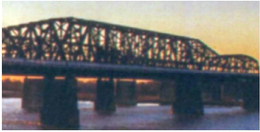Harahan turns 100

Harahan turns 100
Future bright for century- old bridge
news@theeveningtimes.com
The Harahan Bridge turns 100 years old today. In that century’s span, the Harahan has bridged the Mississippi River and served both rail and vehicle traffic. Since it was built, trains have always run across the river.
The name of the bridge came from the President of the Illinois Central Railroad a century ago, James Theodore Harahan. The Union Pacific runs the rails now. Cars and trucks traveled across the bridge on the cantilevered roadway from 1916 until 1949, when the Memphis & Arkansas Bridge opened. You can still find people that can tell you about riding across the river via the Harahan back in the day. The bridge has a solid history, connecting east to west for 100 years, but a bright new chapter is about to be written.
Soon people will be telling others about the new way they crossed on the Harahan, thanks to developments currently underway.
The Big River Crossing opens Oct. 22, with new boardwalks on that old roadway. The bicycle and pedestrian path will be part of the developing Big River Trail. Set to open to the public alongside the new crossing is the Delta Regional River Park in West Memphis. The bike-ped path continues from the western foot of the Harahan and loops north around the Hernando Desoto Bridge and back.
The park will place the visitor in “two worlds” between the two bridges, with vistas of the Memphis skyline and the Chickasaw Bluffs from the natural setting along that first leg of the Big River Trail in the Natural State.
Memphis Mayor Jim Strickland announced in June a donation to install and maintain artistic LED lights on both bridges to frame the scene for tourists at night.
“They'll be programmable, capable of displaying millions of colors in static and moving patterns coordinated between the two bridges,” said Strickland.
“It's our hope to have the lighting of the Harahan ready by Oct. 22. The lighting for the Desoto Bridge will be completed at a later date.”
The artistic lights with bridge bookends will not only reflect off the water but planners hope to make the area shine for tourists.
The lighting contractor, Philips, has previously designed and installed projects that draw visitors to the Empire State Building, the Bay Bridge in California, and the four bridges over the Arkansas River in Little Rock.
With the Big River Trail on the ground, the $12 million private donation to develop, install and maintain the lights for the two bridges provided a no-taxpayer- cost way to turn the two bridges and trail through the new river side park in West Memphis into an overnight tourist attraction.
“The trail running atop the river's extensive levees system will be the longest of its type in the world, and are expected to become a significant amenity and major tourist attraction for our region,” said Charlie D. McVean, Chairman of the Big River Strategic Initiative.
Citing a survey on tourism the director told a joint meeting of West Memphis City Council and the Advertising & Promotion Commission that “Geotravelers” and cyclists drive tourism dollars to new heights. Cyclists tour an area slower and stay longer than a motorist.
“They not only spend more money per day, but they also tend to have a longer stay,” said Terry Eastin, Director Big River Strategic initiative. “The data shows that Geo-travelers are worth about $375 more per person per destination.”
Development funds for the 1,700-acre Delta Regional River Park in West Memphis came form a consortium of contributors. The 1.5 million dollar collected foots the bill for the first phase of the trail. A $200,00 Arkansas Recreational Trails fund grant, $250,000 from West Memphis Advertising and Promotion, $162,500 from the Big River Strategic Initiative for engineering fees work with a million-dollar dip into the West Memphis regional planning and congestion mitigation funds.
The park provides an attractive activity for bike riders to spin their way along the nature trail on the West Memphis end of the Main-to-Main Project connecting cyclists from all points along the green line path through Memphis. A look beyond the Delta Regional River Park reveals a whole new parkway system of trails that make the Arkansas Gateway city the hub in a network of bike trails.
The Army Corps of Engineers stepped up with 7 million dollars worth of gravel fines to smooth out levee tops along 73 mile along the west bank of the Mississippi form Marion to Marianna going south from the city. Another $100,000 for signs marking the trail came from an Arkansas Economic Development Grant. An additional proposal connects this trail with the 89-mile Arkansas Delta Heritage Trail from West Helena to Arkansas City. The long range vision sees the Harahan Bridge as a cycling hub but places West Memphis in the middle of a trail network from new Orleans to St. Louis and along the Mississippi all the way north.
The Big River big vision includes direct flights from china to Memphis and a catamaran fleet to shuttle cyclists back form points along the bike trail network to the foot of the Harahan and the river park in West Memphis.

By John Rech


Share